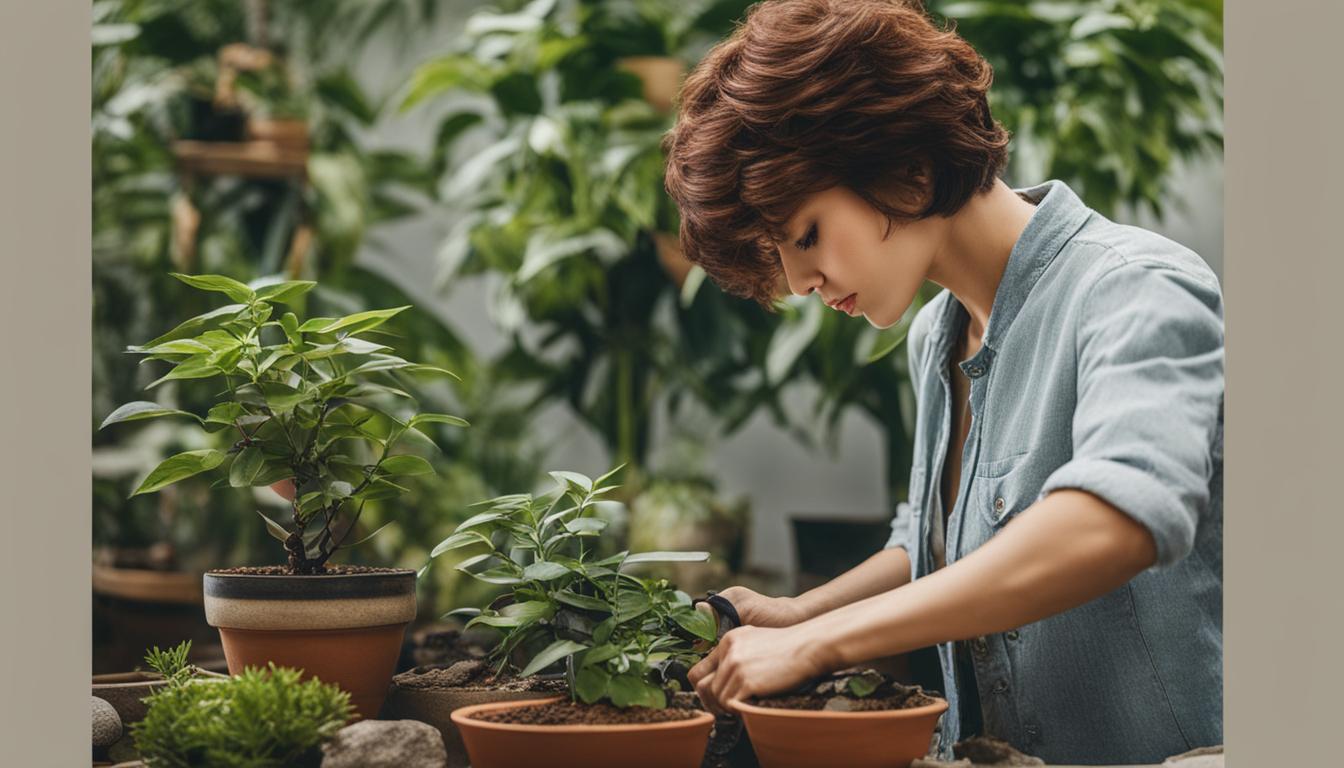Originally posted on October 28, 2023 @ 11:37 pm
Are you looking to enhance the positive energy and prosperity in your home? Creating your own Feng Shui tree is a simple and effective way to achieve just that. With our step-by-step guide, you’ll be able to make your very own DIY Feng Shui tree and enjoy the many benefits it provides.
In this section, we will explore the essential steps required to make a Feng Shui tree, including the significance of materials, placement, and decoration.
- Making a Feng Shui tree at home is a simple yet effective way to enhance positivity and prosperity.
- Materials used for the tree are crucial to ensuring its effectiveness.
- Proper placement of the tree is essential for maximum benefits.
- Decorating the tree can enhance its positive energy flow.
- Caring for the tree is important to ensure its continued benefits and energy flow.
Understanding Feng Shui Tree Symbolism
Before you start creating your Feng Shui tree, it’s important to understand the symbolism behind it. The Feng Shui tree is a symbol of growth, balance, and harmony. It represents the natural cycles of life and the connection between earth, water, and sky.
In Feng Shui, trees are considered auspicious and powerful, as they are believed to absorb negative energy and transform it into positive energy. They also bring a sense of vitality and renewal to a space, making them an ideal addition to any home or office.
The type of tree you choose for your Feng Shui tree will depend on your personal preferences and the specific energy you wish to enhance. Some popular choices include the money tree, jade plant, and ficus tree, each with their own unique symbolism and significance.
The placement of your Feng Shui tree is also crucial. Depending on the specific area and energy you wish to enhance, you may want to place your tree in different locations. For example, a money tree is often placed in the wealth corner of the home, while a jade tree may be placed in the health or knowledge corner.
Overall, the Feng Shui tree is a powerful symbol of growth, balance, and positive energy. By understanding its symbolism and significance, you can create a harmonious and prosperous living space.
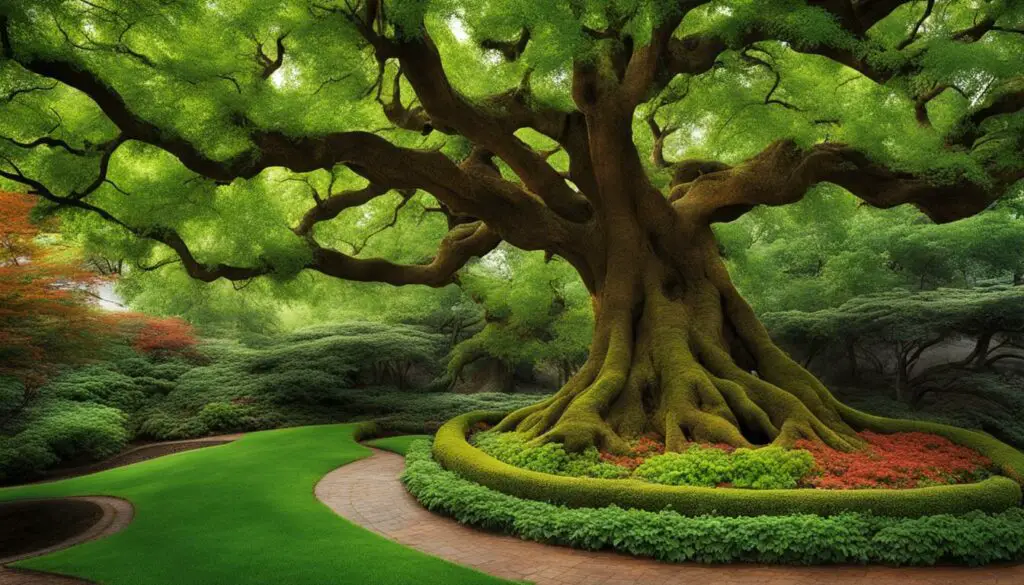
Choosing the Right Materials for Your Feng Shui Tree
When creating a Feng Shui tree, your choice of materials is essential to ensure its effectiveness in bringing balance and harmony to your living space. Here are some of the materials you can use and how they can enhance the energy flow in your home:
| Material | Description | Benefits |
|---|---|---|
| Bonsai Tree | A miniature tree planted in a decorative pot | Symbolizes longevity, prosperity, and growth |
| Lucky Bamboo | A tall, slender plant with stalks in a bundle | Represents luck, prosperity, and wealth |
| Citrine Crystal | A yellow quartz crystal | Attracts abundance, prosperity, and success |
| Coins | Real or replica Chinese coins tied with red ribbon | Represents wealth and abundance |
| Red String or Ribbon | A red thread or ribbon | Serves as a symbol of protection and good fortune |
| Crystals and Gemstones | Various crystals and gemstones, such as amethyst and rose quartz | Each gemstone has unique properties that bring positive energy to your space |
Choose the materials that resonate with you the most, and consider the intention that you want to infuse into your Feng Shui tree. You can also combine different materials for a more potent effect.

Note: When placing your materials together, ensure that they complement each other aesthetically. Avoid using too many colors or designs that clash, as this can create disharmony in your space.
Finding the Perfect Location for Your Feng Shui Tree
The placement of your Feng Shui tree is crucial to ensure it enhances the energy flow in your home. Here are some tips to help you find the perfect location:
- Place your tree in the East or Southeast corner of your home to activate the wealth and abundance energies.
- Place the tree in the North to enhance your career and path in life.
- For love and romance, place the tree in the Southwest corner of your bedroom.
- Ensure your tree is not blocking any important doors or windows, and avoid placing it in the center of a room.
It’s also essential to consider the size of your tree and the space where you plan to put it. A small tree can fit on a table or shelf, while a larger tree may need its own designated corner or area.
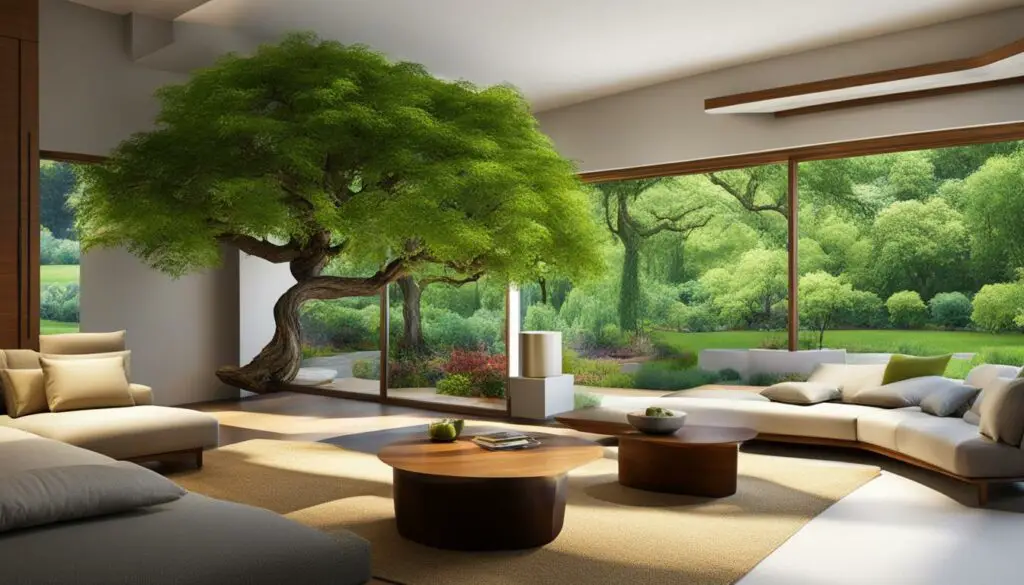
Tip: If you have a small living space, consider creating a miniature Feng Shui tree. You can use a small pot or container with a few carefully chosen elements to create an equally powerful positive energy flow.
Step-by-Step Guide to Creating a DIY Feng Shui Tree
Creating a DIY Feng Shui tree is a fun and easy way to enhance the positive energy in your home. Follow these simple steps to make your own Feng Shui tree:
- Gather your materials. You will need a small tree or plant, a decorative pot or container, soil, rocks or pebbles, and any additional decorations or elements you’d like to include. Be sure to choose materials that align with your intentions and the principles of Feng Shui.
- Plant your tree. Fill the container with soil and plant your tree, being careful not to damage the roots. Add rocks or pebbles to the top of the soil for additional stability and decor.
- Add decorations and elements. This is where you can get creative! Choose decorations and elements that correspond with your intentions and the principles of Feng Shui. Consider adding crystals, gemstones, candles, or other meaningful items that promote positivity and harmony.
- Place your tree in the optimal location. Refer to Section 4 for tips on where to place your Feng Shui tree for maximum effect.
Remember to focus your intentions while creating your Feng Shui tree, infusing it with positive energy and setting clear intentions for what you hope to achieve. With a little creativity and intention, you’ll have a beautiful and energetically potent Feng Shui tree in no time!

Decorating Your Feng Shui Tree for Maximum Effect
Now that you have created your very own Feng Shui tree, it’s time to decorate it to enhance its positive energy. Your imagination is the limit when it comes to decorating your tree, but here are some tips to get you started:
- Choose colors wisely: Colors have a significant impact on the energy flow in your space. Select colors that align with your intentions and the specific area of your home where the tree is placed. For example, greens are ideal for the living room, while blues are suitable for the bedroom.
- Add natural elements: Incorporating natural elements into your tree decoration, such as small stones, crystals, and seashells, can enhance its positive energy and bring a grounding effect.
- Use meaningful symbols: Decorate your tree with symbols that represent your intentions and desires. For example, a small elephant figurine can symbolize strength and wisdom, while a butterfly can symbolize transformation and growth.
Remember that the decoration of your tree should align with your personal preferences and intentions. Don’t be afraid to get creative and add your personal touch!
Check out this beautiful example of a decorated Feng Shui tree:
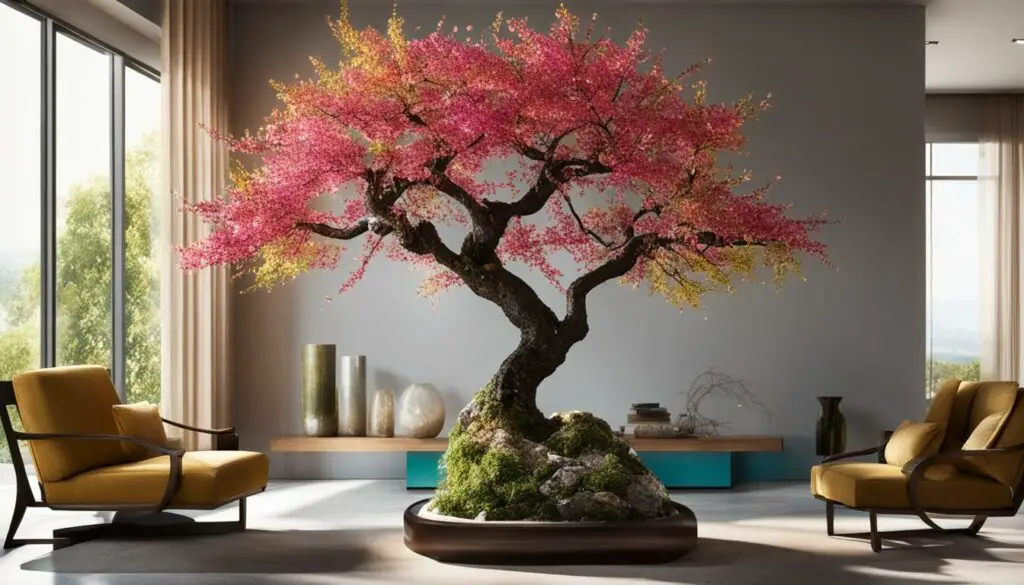
“Decorating your Feng Shui tree is a fun and creative process that can infuse your space with positive energy and reflect your personality and style.”
Caring for Your Feng Shui Tree – Maintenance Tips
Just like any other living thing, your Feng Shui tree needs proper care and maintenance to thrive. Here are some essential tips to ensure that your tree stays healthy and vibrant:
- Watering: Make sure to water your tree regularly and keep the soil moist. However, be careful not to overwater, as this can lead to root rot. A good rule of thumb is to water your tree once a week, but adjust the frequency based on the size and needs of your tree.
- Sunlight: Feng Shui trees require adequate sunlight to grow and thrive. Place your tree in a bright spot that receives plenty of natural light, but avoid direct sunlight, which can scorch the leaves.
- Pruning: Regular pruning helps your tree maintain its shape and encourages new growth. Use sharp, clean pruning shears to trim any dead or damaged branches, and shape the tree as desired.
- Cleaning: Dust and debris can accumulate on the leaves and branches of your tree, hindering its energy flow. Use a clean, damp cloth to wipe down the leaves and branches regularly, and remove any dead leaves or debris from the soil.
- Fertilizing: To encourage healthy growth, you can fertilize your Feng Shui tree every few months. Use a balanced, water-soluble fertilizer and follow the instructions carefully.

By following these simple care tips, you can ensure that your Feng Shui tree remains healthy and vibrant, bringing positive energy and prosperity to your home.
Benefits of Having a Feng Shui Tree at Home
A Feng Shui tree is more than just a decoration – it’s a powerful tool for improving the energy flow in your living space. Here are some benefits of having a Feng Shui tree at home:
- Attracting prosperity: A Feng Shui tree can bring wealth and prosperity into your life, as it is thought to symbolize growth and abundance.
- Removing negative energy: A Feng Shui tree can purify the air and remove negative energy from your home, creating a more harmonious environment.
- Improving health: Certain types of Feng Shui trees are believed to have healing properties, such as the Money Tree and the Jade plant. These trees can improve air quality and promote a sense of calm and relaxation.
- Increasing positivity: A Feng Shui tree can enhance the positive energy in your home, promoting feelings of joy, peace, and contentment.
By incorporating a Feng Shui tree into your home, you can create a space that is not only aesthetically pleasing but also energetically potent. Discover the benefits for yourself and enjoy a more balanced and prosperous life.
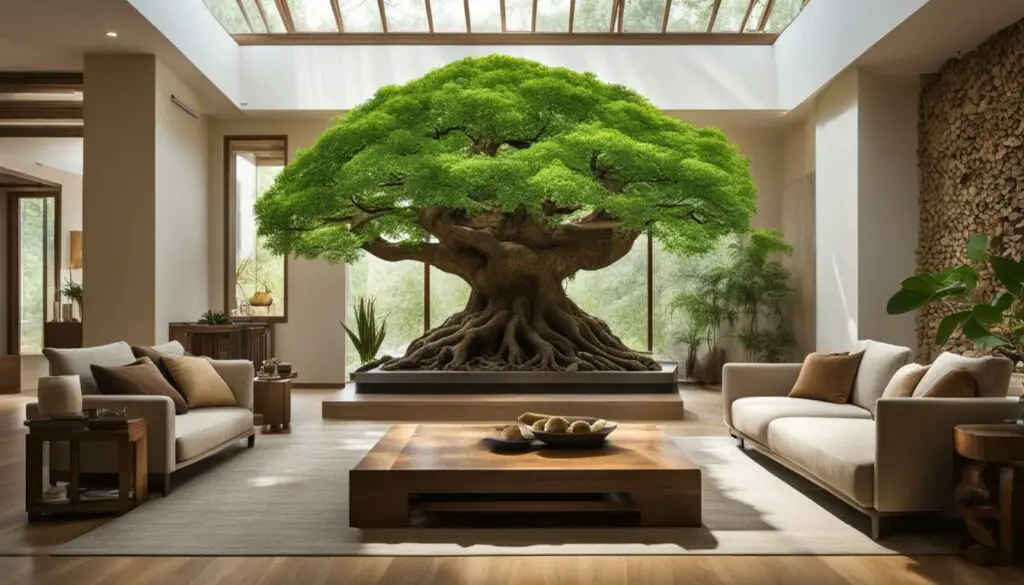
Incorporating Feng Shui Principles into Your Tree Design
Creating a Feng Shui tree is not just about aesthetics; it’s also about incorporating specific principles to maximize its positive energy flow. Here are some essential Feng Shui principles to consider:
Colors
Colors play a significant role in Feng Shui, and choosing the right colors for your tree can enhance its energy. Green is the most commonly used color for a Feng Shui tree, as it represents growth, prosperity, and abundance. Blue and purple are also excellent choices, as they promote calmness and serenity. Avoid using red, as it can create an excessive and overwhelming energy flow.
Shapes
The shape of your tree can also affect its energy flow. Rounded shapes promote a gentle and calming energy, while angular shapes can create a more dynamic and active flow. Triangular shapes can stimulate growth and upward movement, making them ideal for manifesting success and progress.
Materials
The materials for your tree should be chosen carefully, taking into account the five elements of Feng Shui: wood, metal, earth, fire, and water. Wood is the most commonly used element for a Feng Shui tree, as it promotes growth and vitality. Metal and earth elements can create a more grounding effect, while fire and water elements can add a dynamic energy flow.
When selecting materials, consider using natural materials such as wood, bamboo, or crystals, as they can enhance the energy of your tree. Avoid using plastic or synthetic materials, as they can negatively impact the energy flow.
By incorporating these Feng Shui principles into your tree design, you can create a powerful tool for manifesting your desires and enhancing the energy flow in your space.
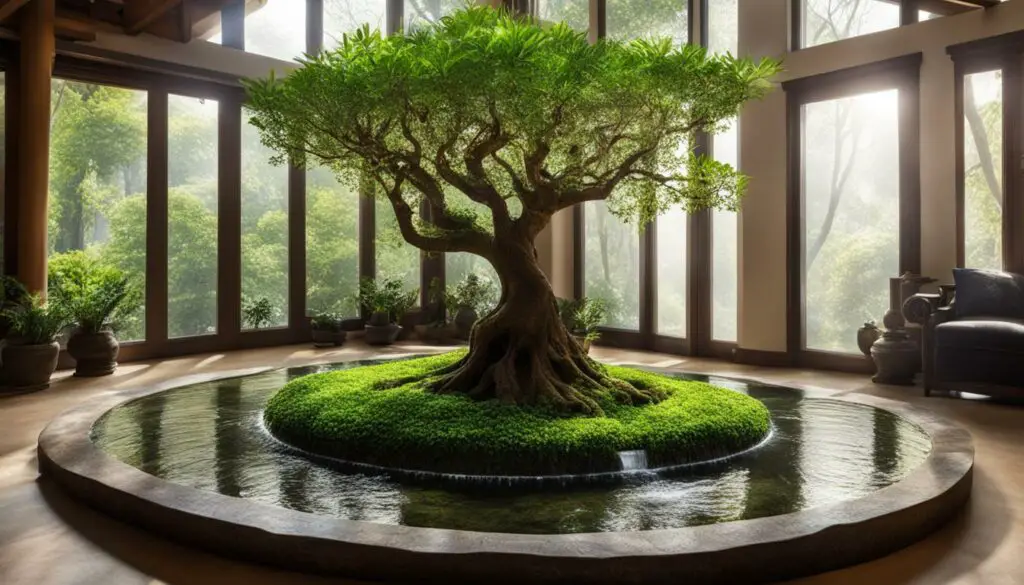
Feng Shui Tree Placement for Specific Areas of Your Home
When it comes to Feng Shui, the placement of your tree is crucial to maximize its positive effects. Different areas of your home may benefit from the presence of a Feng Shui tree more than others. In this section, we will guide you on where to place your tree for optimal energy flow in specific areas.
The Entrance
Placing a Feng Shui tree near your entrance can invite positive energy into your home and ward off negative energy. Ideally, the tree should be placed on the left side of the entrance, as you face into the house, to provide balance and support in career, health, and wealth. A tall tree with strong upward growth is most suitable for this area.

The Living Room
The living room is often the central gathering space in your home. Placing a Feng Shui tree in this area can promote harmony and well-being for your family and guests. A tree with a balanced shape and lush leaves is best suited for this space. Place it in the southeast corner or the east side of the room for optimal energy flow.
The Bedroom
Having a Feng Shui tree in your bedroom can promote restful sleep and a peaceful atmosphere. However, be mindful not to place the tree too close to the bed, as it may disrupt the flow of energy. A small-sized tree with soft leaves such as Bamboo Palm is great for this area. Place it on the east side of the room for health or southeast corner for abundance.
The Dining Area
A Feng Shui tree in the dining area can enhance the energy of nourishment and gathering. Place it in the center of the table to promote a sense of togetherness and encourage healthy conversations. A small-sized tree that can be easily moved is best suited for this area.
Remember, these are just general guidelines, and you should always trust your intuition when it comes to the placement of your Feng Shui tree. The most crucial factor is that it brings you joy and positive energy.
Incorporating Feng Shui Principles into Your Tree Design
Now that you’ve learned how to create your own Feng Shui tree and the significance behind it, it’s time to take it to the next level. By incorporating specific Feng Shui principles into your tree design, you can amplify its positive energy and customize it to align with your personal intentions.
One essential aspect to consider is the choice of colors for your tree. Each color has its own symbolic meaning and can influence the energy flow in your home. For example, green symbolizes growth and abundance, while red represents passion and vitality.
Another important factor is the shape of your tree. Try to use curved branches instead of straight ones to promote a smooth and flowing energy. You can also include objects with rounded shapes, such as pebbles or rounded crystals, to enhance this effect.
The materials you use in your tree design can also affect its energy flow. Consider using natural materials such as wood, stones, and crystals to connect with the earth element and promote grounding energy.
Customizing Your Feng Shui Tree for Personal Intentions
One of the most exciting aspects of creating a Feng Shui tree is the ability to customize it for your personal intentions. Whether you want to invite love, wealth, or success into your life, your tree can serve as a powerful manifestation tool.
Try incorporating objects that represent your desires into your tree design. For example, if you want to attract love, include a pair of mandarin ducks. Or, if you want to enhance your career, add a plant with round leaves like a jade plant.
Remember to infuse your tree with positive energy and intentions as you create it. This will help to amplify its power and bring your desires into manifestation.
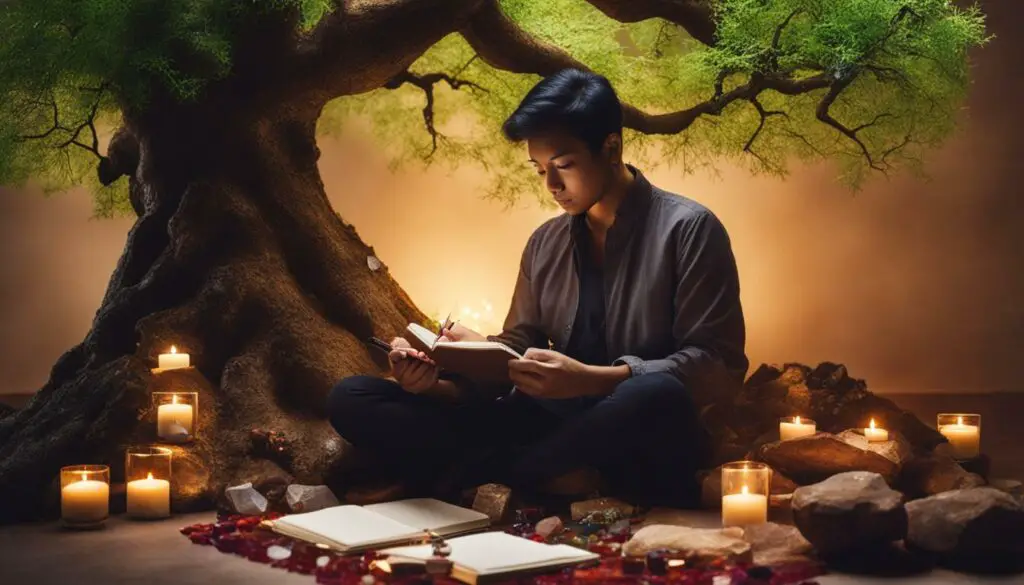
Feng Shui Colors and Their Meanings
| Color | Meaning |
|---|---|
| Green | Growth and abundance |
| Red | Passion and vitality |
| Yellow | Harmony and happiness |
| Black | Protection and introspection |
| White | Purity and clarity |
Enhancing Feng Shui Energy with Additional Elements
While creating a Feng Shui tree is a powerful way to invite positive energy into your home, there are additional elements you can add to further amplify its effects. Incorporating these enhancements can elevate the overall energy flow in your space, bringing balance and harmony to your living environment.
Gemstones and Crystals
Gemstones and crystals are believed to have unique energetic properties that can enhance the Feng Shui energy in your home. Consider adding crystals such as amethyst, rose quartz, or citrine to your Feng Shui tree to bring in calming, loving, or prosperous energy, respectively. You can also place them around your tree or in different areas of your home to further enhance their energetic effects.

Wind Chimes
Wind chimes are not only aesthetically pleasing, but they can also increase the flow of positive energy in your home. Consider adding wind chimes to your Feng Shui tree or in areas where the wind naturally passes. The sound of the chimes can create a soothing atmosphere that promotes peace and relaxation.
Fountains
Fountains are a popular addition to any Feng Shui space, as they symbolize abundance and prosperity. Adding a fountain near your Feng Shui tree can create a soothing atmosphere and invite positive energy into your space. Consider choosing a fountain that suits your personal style and preferences to maximize its effects.
Mirrors
Mirrors can amplify the energy flow in your home by reflecting and expanding the positive energy. Consider adding mirrors to your Feng Shui tree area or in areas where you want to increase the energy flow. Be mindful of the placement of the mirrors to ensure they reflect positive energy and don’t create negative energy.
Plants
Plants are a natural addition to any Feng Shui space, as they promote growth and healing. Consider adding plants to your Feng Shui tree area or in different areas of your home to purify the air and enhance the energy flow. Choose plants with rounded or soft leaves, such as the snake plant or peace lily, to promote calm and relaxation.
Adding these additional elements to your Feng Shui tree can significantly enhance the energy flow in your home. Experiment with different combinations and see how they affect the overall energy in your living space. With the right additions, your Feng Shui tree can become a powerful positive force in your home.
Conclusion
Creating a Feng Shui tree at home is a simple and effective way to enhance the energy flow in your living space while inviting positivity and prosperity into your life. Remember to understand the symbolism behind Feng Shui trees before you begin and choose the right materials for maximum effectiveness.
Pay attention to the placement of your tree, ensuring it’s located in an area that aligns with your intentions and goals. Don’t forget to personalize your tree to match your desires and beliefs, infusing it with your unique energy.
Decorating your tree with intention and maintaining it with care and attention will ensure its positive energy continues to flow. Consider adding additional elements to enhance the energy flow in your home further.
Experience the many benefits of incorporating Feng Shui principles into your home design by creating your own Feng Shui tree today!
FAQ
How long does it take to make a Feng Shui tree?
The time it takes to make a Feng Shui tree depends on your level of creativity and the materials you choose. Generally, it can take anywhere from a few hours to a couple of days to complete.
Do I need any special skills to create a Feng Shui tree?
No special skills are required to make a Feng Shui tree. It is a DIY project that anyone can easily learn and enjoy. Just follow the step-by-step guide and let your creativity flow!
Can I use any type of tree for my Feng Shui tree?
Yes, you can use any type of small indoor plant or tree for your Feng Shui tree. Just make sure it aligns with your intentions and the energy you want to attract.
Where can I find the materials to create a Feng Shui tree?
You can find the materials for your Feng Shui tree at craft stores, plant nurseries, or even in your own backyard. Look for items like decorative rocks, crystals, ribbons, and other elements that resonate with you.
How do I know where to place my Feng Shui tree?
The placement of your Feng Shui tree depends on the specific area of your home you want to enhance. Generally, it is recommended to place it in the wealth corner, the entrance, or any area that needs a boost of positive energy.
Do I need to water my Feng Shui tree?
Yes, your Feng Shui tree is a living plant and requires regular watering to stay healthy. Be sure to follow the specific watering instructions for the type of tree you have chosen.
Can I decorate my Feng Shui tree with specific colors?
Yes, you can decorate your Feng Shui tree with colors that correspond to specific intentions or energies. For example, green represents growth and abundance, while red symbolizes passion and vitality.
What are the benefits of having a Feng Shui tree?
Having a Feng Shui tree can bring numerous benefits, including improved energy flow, increased prosperity, enhanced focus and creativity, and a sense of peace and harmony in your living space.
Can I customize my Feng Shui tree with personal intentions?
Absolutely! You can infuse your Feng Shui tree with your personal intentions or wishes to manifest what you desire in your life. This adds a powerful personal touch to the energy of your tree.
Should I regularly cleanse and recharge my Feng Shui tree?
Yes, it is a good practice to regularly cleanse and recharge your Feng Shui tree to keep its energy vibrant and potent. You can do this by gently dusting the leaves, placing it under moonlight, or using other cleansing methods that resonate with you.
Can I place my Feng Shui tree in any room of my home?
Yes, you can place your Feng Shui tree in any room of your home that needs a boost of positive energy. However, it is important to consider the specific principles and energies associated with each area to optimize its placement.
